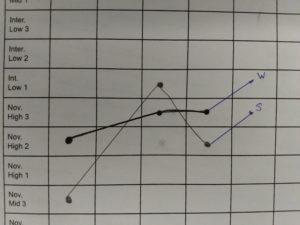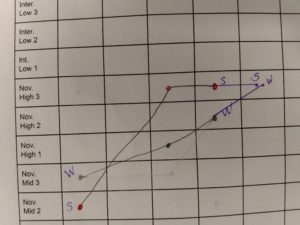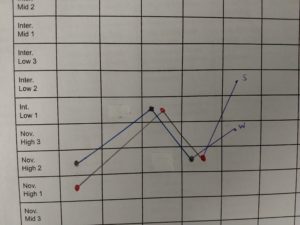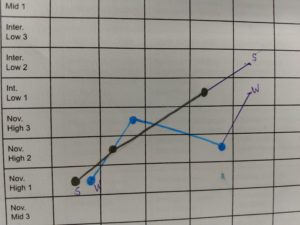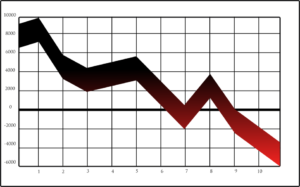 Thursday evening on #langchat we had a great discussion about what had worked well for us in 2017. When I shared that I had begun having my students graph their progress toward proficiency, several people expressed interest. So I thought I’d type up a quick post about what we’ve been doing and what I’ve learned from the process.
Thursday evening on #langchat we had a great discussion about what had worked well for us in 2017. When I shared that I had begun having my students graph their progress toward proficiency, several people expressed interest. So I thought I’d type up a quick post about what we’ve been doing and what I’ve learned from the process.
I began by passing out this document when I returned the students’ first IPA of the year. Although I am clearly evaluating classroom performance in my assessments, it is important to me that my students see their progress in terms of language proficiency, so I use the proficiency rubrics from the Ohio Department of Education for presentational writing and interpersonal speaking. As the directions on the graph document indicate, I had the students place a dot in the appropriate square for each IPA and then draw a line connecting their dots. I had them use the same graph, but two different colored lines for presentational writing and interpersonal speaking. Here are a few of the graphs from my French 2 classes:
There are a few reasons why I consider the simple task of graphing proficiency/performance progress to be one of my successes in 2017. For one, I LOVED the conversations that I heard among my students as they completed their graphs each time. It is so much more meaningful to hear “I moved up to Intermediate Low 1” than “I got a B.” These graphs are also a great visual for my students. As we transition toward teaching for proficiency (and away from discrete point assessments) some students question “what” they’re learning. These graphs help students to see their progress in a concrete way.
These graphs also inform my instructional and assessment practices. Because nearly every student performed lower on the 3rd IPA, I had to take a long, hard look at this assessment (from this post). My conclusion is that the prompts that I used for the writing and speaking tasks did not encourage the students to stretch in a way that would demonstrate their highest proficiency/performance. Few students ask the variety of questions that would enable them to demonstrate Intermediate interpersonal communication and most did not include the compound sentences, creativity and cultural competence described in the Intermediate descriptors for the presentational mode. I clearly need to either change these prompts and provide additional direction and targeted practice the next time I teach this unit. I also wonder whether some of the results may indicate a lack of evaluator reliability on my part. As with most rubrics, there is a bit of subjectivity and I hope to increase my consistency as I continue to use these rubrics.
Image Credit: http://www.publicdomainfiles.com/show_file.php?id=13489790414892

